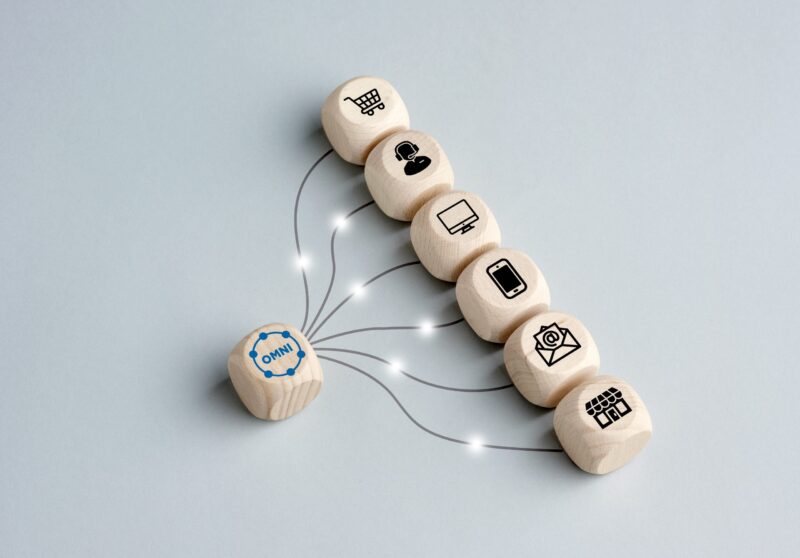Omnichannel fulfillment benefits, challenges, and strategies
Omnichannel fulfillment is a strategy where retailers use multiple sales channels, like online stores, physical shops, and mobile apps, to efficiently manage and deliver products to customers wherever and however they choose to shop.

Ioana Neamt

In the great ecommerce vs brick-and-mortar debate, the answer seems more and more to be, both. Both answer the very real needs of a great many people, and they each have a place in the relationship between a brand and its customers. But how can a business thrive in both worlds? Omnichannel fulfillment might be your answer to that — a centralized strategy that helps you seamlessly manage all your sales channels, both online and offline.
What is omnichannel fulfillment?
Omnichannel fulfillment is a retail approach that seamlessly integrates various shopping platforms. It connects online stores, physical locations, and mobile apps to manage and deliver products to customers according to their preferred method of purchase and delivery.
You can think of it as a retail version of “all roads lead to Rome.” It is a strategy that manages orders that come through various sales channels and seamlessly fulfillis them.
An important note to make is that omnichannel is not to be confused with multichannel retail — while it also means working with several sales channels, they each operate independently in the multichannel model.
Why is omnichannel order fulfillment important?

Moving your inventory effectively is a goal where all your operational routes meet. In an omnichannel fulfillment model, all your paths are interconnected and can act as a strong foundation for better business performance, as well as a great experience for customers. In fact, the omnichannel approach is very customer-oriented, in that it makes it easy to make your products available to consumers in any way that is most convenient for them.
Benefits of the omnichannel fulfillment strategy
Most of the benefits you gain by implementing omnichannel fulfillment are related to and stemming from improving your relationship with your customers. Below, we detail what are perhaps the three most important benefits of omnichannel fulfillment.
- Customer convenience
- Streamlining the fulfillment process
- Cost savings
Customer convenience
Making the effort to meet the different needs of different people has the added effect of expanding your pool of customers. Offering options such as in-store pick-up, home delivery, or even same-day delivery makes your products more easily accessible to more people. Creating a convenient and reliable shopping experience builds trust for your company, reduces shopping cart abandonment, and drives recommendations that will attract even more customers over time.
Did you know?
The cart abandonment rate is one of the biggest issues for online retailers. In 2024, about 70% of shoppers abandoned their carts.
Streamlining the fulfillment process
With omnichannel fulfillment, you manage your inventory as a whole and you need to operate in certain ways to make it work well. For instance, to create that convenient customer experience, you have to optimize your back-end operations, streamline order picking and packing processes, and reduce errors. By streamlining your order fulfillment process, you also achieve better use of staff resources and more efficient delivery options.

Cost savings
When you optimize inventory allocation with omnichannel fulfillment, you can potentially hold less overall stock and, in turn, save on storage costs. What’s more, streamlining your back-end processes also means optimizing the use of staff time and resources — when your inventory is well organized, it takes your staff less time and effort to locate, pick, and pack an order. Reducing the error rate in your fulfillment process contributes greatly to building the trust your business receives from your client base, which can eventually translate into lower marketing costs.
Challenges of omnichannel ecommerce fulfillment
Of course, for all its benefits, no business strategy comes without its challenges. Let’s look at the top three challenges businesses face with omnichannel fulfillment.
- Complexity
- Inventory management
- Upfront costs
Complexity of implementation
If this interconnected network of all pieces working in harmony sounds like a very complex undertaking, that’s because it is. For a successful approach, you need to have a well-integrated system that seamlessly and reliably connects to all of the elements of your operation:
- Online store
- Physical storefront
- Storage
- Inventory management
- Fulfillment providers, etc.
All this can be challenging to maintain, especially if your business has a highly diverse product range and operates with a large number of sales channels.
Inventory management challenges
For optimal results using omnichannel fulfillment, you need to have accurate real-time visibility and control over your inventory, across all locations. The more warehouses or fulfillment centers you work with, the more challenging omnichannel inventory management will be, but it is extremely important to ensure data accuracy and optimize inventory allocation so that you don’t end up having to deal with stockouts or paying the price for overstocking.

Upfront costs
While you end up saving costs in the long run, setting up everything you need for an omnichannel fulfillment strategy to be successful does entail some upfront investment. Implementing dedicated software solutions, integrating all the moving pieces so that the process can run smoothly in all directions, expanding the variety of fulfillment options for your clients, as well as training your staff on all the changes and tools will take up time and financial resources.
8 Omnichannel fulfillment strategies and examples
There are many ways to create a positive and reliable shopping experience for your customers with omnichannel fulfillment. In fact, the number of ways to sell products grows almost by the day, as more platforms evolve to better accommodate the modern sale process and the needs of shoppers (ecommerce, brick and mortar, social apps, wholesale, etc.)
- Buy online, pick up in-store
- Ship order to store
- Ship order from the store
- Ship order to the customer
- Marketplace integration
- In-app purchases
- Interactive kiosks and touchpoints
- Third-party logistics

1. Buy online, pick up in-store
One of the most popular win-win strategies, BOPIS, is convenient for both the retailers and the client. The customer makes their purchase online and is then free to pick it up from a physical store location — a convenient way for the client to integrate the interaction into their schedule and a good way for the retailer to hand over the items with minimal shipping.
2. Ship order to store
This strategy is high up there with the pick-up in-store option, in terms of convenience for the customer. When they place an order online, they can be given the option to choose a store that is located conveniently for them, where they can pick up their order. The items are then shipped to that store and the customer is notified when the order is available.
3. Ship order from store
In this scenario, a physical retail location can act as a mini-distribution center. When the customer places an order, the item can be shipped from the nearest store instead of from a centralized warehouse, which could mean a longer shipping time.
4. Ship order to customer location
This is perhaps the most traditional ecommerce model, whereby the requested items are shipped directly to the customer’s home or other location of choice. Depending on how your fulfillment process is set up, shipping can be from a centralized distribution center or from nearby retail stores.
5. Marketplace integration
This can be a powerful strategy to enhance your reach and increase your sales. Connecting your online store or business with a popular third-party online marketplace is a great way to tap into a vast existing customer base. It can be convenient for customers of yours who already use that marketplace to interact with your brand there, as well as a great way to introduce your brand to new customers.
6. In-app purchases
This is another way to provide a seamless and convenient experience for customers to interact with and shop from your brand. In addition to your website, you can offer a mobile app to act as another storefront for your business. For added convenience to the customer, they should be able to seamlessly switch back and forth between your platforms without loss of cart information, to complete their order as best fits their needs at the moment.
7. Interactive kiosks and touchpoints
Interactive kiosks or touchpoints can play a valuable role in your omnichannel fulfillment strategy. By offering additional data, well-crafted recommendations, and options for ordering, they can significantly enhance the customer experience. Examples of what you can offer your clients in this regard include product details and reviews, the possibility to check inventory availability, interactive features and product demos, personalized promotions, product comparison, order tracking, and other self-service options.
8. Third-party logistics
Similarly to the marketplace integration strategy, you can leverage the reach and capabilities of a third-party logistics supplier to handle your order fulfillment. You can outsource some or even all of your warehousing, fulfillment, and transportation needs to highly specialized and well-optimized third-party partners. This frees up resources for you to focus on core operations like product development and marketing.
Master omnichannel fulfillment with Katana

Luckily, modern software solutions have been staying ahead of the curve in terms of meeting the challenges of businesses employing omnichannel fulfillment strategies as they keep scaling up. With Katana’s cloud-based solutions, you can easily tackle the challenges of complexity, accuracy, integration, and more.
- Real-time view of all your sales channels, both online and offline
- Seamless integration with the best ecommerce platforms
- Set up and sync your inventory across all channels
- Unified order management
- And much, much more!
Reach out to schedule a demo so we can show you how you can manage all aspects of your business from one platform and how you can easily set up your omnichannel sales strategy with our support.
FAQs
If your goal is to provide a consistent shopping experience for your customers, regardless of how they choose to interact with your brand, a cloud-based solution increasingly proves to be the best way to go. Omnichannel management software such as the comprehensive solutions provided by Katana makes it easy to streamline your data flows, optimize your back-end process, and make your clients’ experience memorably convenient.
A multichannel strategy focuses mainly on making your products available through multiple channels, which largely operate independently from each other. Meanwhile, the main focus of an omnichannel fulfillment strategy is to create a unified experience for your customers, no matter how they choose to buy your products.
The supply chain in an omnichannel fulfillment strategy integrates all of your various online and offline sales channels so that data and items can seamlessly move between them — brick-and-mortar stores, online stores, mobile apps, and any other order option that you can give your customers.

Ioana Neamt
Table of contents
Get inventory trends, news, and tips every month
Get visibility over your sales and stock
Wave goodbye to uncertainty with Katana Cloud Inventory — AI-powered for total inventory control